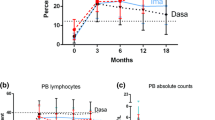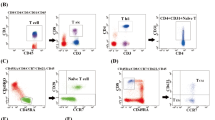Abstract
Lymphocytosis in response to dasatinib for chronic myelogenous leukemia (CML) may be associated with favorable response. However, it occurs at varying times and in a limited subset of patients. To identify early clinical markers for favorable responses applicable to all patients with or without lymphocytosis, we prospectively analyzed lymphocyte profiles of 50 Japanese CML patients treated with dasatinib after intolerance/resistance to imatinib. Although absolute lymphocyte counts did not differ significantly until 3 months between patients with complete molecular response (CMR) at 12 months and those without it, relative increases in lymphocyte compared with baselines differed significantly from 1 month. Patients with relative lymphocyte counts >150 % at 1 month or >200 % at 3 months had higher CMR rates at 12 months than others (57.9 vs. 23.3 %, P = 0.015, and 76.5 vs. 16.1 %, P < 0.0001, respectively). A relative increase in lymphocyte subset of CD57+CD14−, CD8+T, or NK cells >200 % at 1 month was also significantly associated with a higher CMR rate. There were significant negative correlations between relative lymphocyte increases and BCR/ABL transcript levels. CD57+CD14− cells were a highly specific focus of proliferation. Relative increases in lymphocyte count and its subsets from 1 month are reliable early markers of favorable responses to dasatinib.




Similar content being viewed by others
References
Faderl S, Talpaz M, Estrov Z, O’Brien S, Kurzrock R, Kantarjian HM. The biology of chronic myeloid leukemia. N Engl J Med. 1999;341:164–72.
Lugo TG, Pendergast AM, Muller AJ, Witte ON. Tyrosine kinase activity and transformation potency of bcr-abl oncogene products. Science. 1990;247:1079–82.
Cohen MH, Williams G, Johnson JR, Duan J, Gobburu J, et al. Approval summary for imatinib mesylate capsules in the treatment of chronic myelogenous leukemia. Clin Cancer Res. 2002;8:935–42.
Gleevec (imatinib mesylate) tablets: prescribing information, Rev. edn. East Hanover: Novartis Pharmaceuticals, November 2007.
Druker BJ. Translation of the Philadelphia chromosome into therapy for CML. Blood. 2008;112:4808–17.
The chronic myelogenous leukemia clinical practice guidelines in oncology, version 1. Washington, DC: National Comprehensive Cancer Network, 2009.
Baccarani M, Saglio G, Goldman J, Hochhaus A, Simonsson B, Appelbaum F, et al. Evolving concepts in the management of chronic myeloid leukemia: recommendations from an expert panel on behalf of the European leukemia net. Blood. 2006;108:1809–20.
Baccarani M, Cortes J, Pane F, Niederwieser D, Saglio G, Apperley J, et al. Chronic myeloid leukemia: an update of concepts and management recommendations of European leukemia net. J Clin Oncol. 2009;27:6041–51.
Kantarjian H, Shah NP, Hochhaus A, Cortes J, Shah S, Ayala M, et al. Dasatinib versus imatinib in newly diagnosed chronic-phase chronic myeloid leukemia. N Engl J Med. 2010;362:2260–70.
Saglio G, Kim DW, Issaragrisil S, le Coutre P, Etienne G, Lobo C, ENESTnd Investigators, et al. Nilotinib versus imatinib fornewly diagnosed chronic myeloid leukemia. N Engl J Med. 2010;362:2251–9.
Sprycel (dasatinib): prescribing information, Rev. edn. New York: Bristol-Myers Squibb, November 2007.
Mannaioni PF, Di Bello MG, Masini E. Platelets and inflammation: role of platelet-derived growth factor, adhesion molecules and histamine. Inflamm Res. 1997;46:4–18.
Appel S, Balabanov S, Brümmendorf TH, Brossart P. Effects of imatinib on normal hematopoiesis and immune activation. Stem Cells. 2005;23:1082–8.
Chen J, Schmitt A, Chen B, Rojewski M, Rübeler V, Fei F, et al. Nilotinib hampers the proliferation and function of CD8+ T lymphocytes through inhibition of T cell receptor signalling. J Cell Mol Med. 2008;12(5B):2107–18.
Schade AE, Schieven GL, Townsend R, Jankowska AM, Susulic V, Zhang R, et al. Dasatinib, a small-molecule protein tyrosine kinase inhibitor, inhibits T-cell activation and proliferation. Blood. 2008;111:1366–77.
Blake SJ, Bruce Lyons A, Fraser CK, Hayball JD, Hughes TP. Dasatinib suppresses in vitro natural killer cell cytotoxicity. Blood. 2008;111:4415–6.
Schade AE, Schieven GL, Townsend R, Jankowska AM, Susulic V, Zhang R, et al. Dasatinib inhibits recombinant viral antigen-specific murine CD4+ and CD8+ T-cell responses and NK-cell cytolytic activity in vitro and in vivo. Exp Hematol. 2009;37:256–65.
Porkka K, Khoury HJ, Paquette RL, Matloub Y, Sinha R, Cortes JE. Dasatinib 100 mg once daily minimizes the occurrence of pleural effusion in patients with chronic myeloid leukemia in chronic phase and efficacy is unaffected in patients who develop pleural effusion. Cancer. 2010;116:377–86.
Kreutzman A, Juvonen V, Kairisto V, Ekblom M, Stenke L, Seggewiss R, et al. Mono/oligoclonal T and NK cells are common in chronic myeloid leukemia patients at diagnosis and expand during dasatinib therapy. Blood. 2010;116:772–82.
Nagata Y, Ohashi K, Fukuda S, Kamata N, Akiyama H, Sakamaki H. Clinical features of dasatinib-induced large granular lymphocytosis and pleural effusion. Int J Hematol. 2010;91:799–807.
Mustjoki S, Ekblom M, Arstila TP, Dybedal I, Epling-Burnette PK, Guilhot F, et al. Clonal expansion of T/NK-cells during tyrosine kinase inhibitor dasatinib therapy. Leukemia. 2009;23:1398–405.
Kim DH, Kamel-Reid S, Chang H, Sutherland R, Jung CW, Kim HJ, et al. Natural killer or natural killer/T cell lineage large granular lymphocytosis associated with dasatinib therapy for Philadelphia chromosome positive leukemia. Haematologica. 2009;94:135–9.
Valent JN, Schiffer CA. Prevalence of large granular lymphocytosis in patients with chronic myelogenous leukemia (CML) treated with dasatinib. Leuk Res. 2011;35:e1–3.
Lee SJ, Jung CW, Kim DY, Lee KH, Sohn SK, Kwak JY, Kim HJ, Kim IH, Park S, Kim DH. Retrospective multicenter study on the development of peripheral lymphocytosis following second-line dasatinib therapy for chronic myeloid leukemia. Am J Hematol. 2011;86:346–50.
Mustjoki S, Ekblom M, Arstila TP, Dybedal I, Epling-Burnette PK, et al. Association of lymphocytosis following treatment with dasatinib with response and outcome (abstract). J Clin Oncol. 2010;28(15s):Abstract 6553.
Jabbour E, Hochhaus A, Cortes J, La Rosée P, Kantarjian HM. Choosing the best treatment strategy for chronic myeloid leukemia patients resistant to imatinib: weighing the efficacy and safety of individual drugs with BCR-ABL mutations and patient history. Leukemia. 2010;24:6–12.
Yoshida C, Fletcher L, Ohashi K, Wakita H, Kumagai T, Shiseki M, et al. Harmonization of molecular monitoring of chronic myeloid leukemia therapy in Japan. Int J Clin Oncol. 2012;17(6):584–9.
Sokol L, Loughran TP Jr. Large granular lymphocyte leukemia. Oncologist. 2006;11:263–73.
A Hochhaus, G Saglio, C Chuah, C Pavlovsky, MB Bradley-Garelik, A Lambert et al. Dasatinib and imatinib-induced reductions in BCR-ABL transcript levels ≤10 % at 3 months are associated with improved responses in patients with newly diagnosed CML-CP: analysis of molecular response kinetics in the DASISION Trial (abstract). Ann Meet Am Soc Hematol. 2011;Abstract 2767.
Hanfstein B, Müller MC, Hehlmann R, Erben P, Lauseker M, Fabarius A, et al. Early molecular and cytogenetic response is predictive for long-term progression-free and overall survival in chronic myeloid leukemia (CML). Leukemia. 2012;26:2096–102.
Marin D, Ibrahim AR, Lucas C, Gerrard G, Wang L, Szydlo RM, et al. Assessment of BCR-ABL1 transcript levels at 3 months is the only requirement for predicting outcome for patients with chronic myeloid leukemia treated with tyrosine kinase inhibitors. J Clin Oncol. 2012;30:232–8.
Veldurthy A, Patz M, Hagist S, Pallasch CP, Wendtner CM, Hallek M, et al. The kinase inhibitor dasatinib induces apoptosis in chronic lymphocytic leukemia cells in vitro with preference for a subgroup of patients with unmutated IgVH genes. Blood. 2008;112:1443–52.
Mahon FX, Réa D, Guilhot J, Guilhot F, Huguet F, Nicolini F, et al. Discontinuation of imatinib in patients with chronic myeloid leukaemia who have maintained complete molecular remission for at least 2 years: the prospective, multicentre Stop Imatinib (STIM) trial. Lancet Oncol. 2010;11:1029–35.
Takahashi N, Kyo T, Maeda Y, Sugihara T, Usuki K, Kawaguchi T, et al. Discontinuation of imatinib in Japanese patients with chronic myeloid leukemia. Haematologica. 2012;97:903–6.
Tanaka H, Nakashima S, Usuda M. Rapid and sustained increase of large granular lymphocytes and rare cytomegalovirus reactivation during dasatinib treatment in chronic myelogenous leukemia patients. Int J Hematol. 2012;96:308–19.
Mustjoki S, Auvinen K, Kreutzman A, Rousselot P, Hernesniemi S, Melo T, et al. Rapid mobilization of cytotoxic lymphocytes induced by dasatinib therapy. Leukemia. 2013;27:914–24.
Bristol-Myers Squibb. Pharmacokinetics, study CA180-031. (http://www.bms.co.jp/medical/sprycel/11.html). November, 2012.
Kreutzman A, Ladell K, Koechel C, Gostick E, Ekblom M, Stenke L, et al. Expansion of highly differentiated CD8+ T-cells or NK-cells in patients treated with dasatinib is associated with cytomegalovirus reactivation. Leukemia. 2011;25:1587–97.
Powers JJ, Dubovsky JA, Epling-Burnette PK, Moscinski L, Zhang L, Mustjoki S, et al. A molecular and functional analysis of large granular lymphocyte expansions in patients with chronic myelogenous leukemia treated with tyrosine kinase inhibitors. Leuk Lymphoma. 2011;52:668–79.
Cervantes F, Pierson BA, McGlave PB, Verfaillie CM, Miller JS. Autologous activated natural killer cells suppress primitive chronic myelogenous leukemia progenitors in long-term culture. Blood. 1996;87:2476–85.
Silla LM, Pincus SM, Locker JD, Glover J, Elder EM, Donnenberg AD, et al. Generation of activated natural killer (A-NK) cells in patients with chronic myelogenous leukaemia and their role in the in vitro disappearance of BCR/abl-positive targets. Br J Haematol. 1996;93:375–85.
Acknowledgments
This study was supported by the Epidemiological and Clinical Research Information Network (ECRIN). We thank Yumi Miyashita at ECRIN for collecting the data, and Yoshinori Yamamoto at BML for measuring the data.
Conflict of interest
K. N. received research funding from Novartis. S. O received research funding from Bristol-Myers Squibb. The remaining authors declare no competing financial interests.
Author information
Authors and Affiliations
Corresponding author
About this article
Cite this article
Kumagai, T., Matsuki, E., Inokuchi, K. et al. Relative increase in lymphocytes from as early as 1 month predicts improved response to dasatinib in chronic-phase chronic myelogenous leukemia. Int J Hematol 99, 41–52 (2014). https://doi.org/10.1007/s12185-013-1483-9
Received:
Revised:
Accepted:
Published:
Issue Date:
DOI: https://doi.org/10.1007/s12185-013-1483-9




